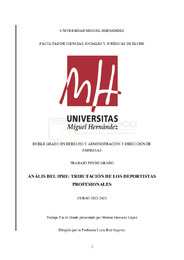Por favor, use este identificador para citar o enlazar este ítem:
https://hdl.handle.net/11000/29906Análisis del IPRF: tributación de los deportistas profesionales
| Título : Análisis del IPRF: tributación de los deportistas profesionales |
| Autor : Gomariz López, Marina |
| Tutor: Ruz Segovia, Lucía |
| Editor : Universidad Miguel Hernández de Elche |
| Departamento: Departamentos de la UMH::Ciencia Jurídica |
| Fecha de publicación: 2023-06 |
| URI : https://hdl.handle.net/11000/29906 |
| Resumen : El IRPF es un tributo que está presente en la vida de la mayor parte de los ciudadanos españoles, siendo éste una de las formas que tiene tanto el Estado como las CCAA de recaudación. A lo largo de este trabajo fin de grado, se va a hacer referencia a los aspectos más relevantes de dicho impuesto (haciendo especial hincapié en los rendimientos del trabajo) de manera que, cualquier contribuyente que se lea la primera parte de la exposición pueda tener una idea general del mismo y así, poder entender cómo funciona dicho impuesto en la praxis y poder crear su propia opinión con conocimiento de causa. En relación con la segunda parte, el sistema de financiación de las Comunidades Autónomas está regulado por la Ley 22/2009, de 18 de diciembre, la cual, en la actualidad, se encuentra en debate puesto que, la misma ha ocasionado discrepancias entre las diferentes Comunidades Autónomas que componen el territorio español como consecuencia de los distintos tipos mínimos y máximos que cada una de ellas ha instaurado para gravar a los contribuyentes. De modo que, a través de la presente exposición, se analizará dicho sistema de financiación autonómica, comparando las diferencias de tributación que existen hoy día entre las CCAA de régimen común lo que nos llevará a poner de manifiesto la razón de por qué existen CCAA más gravosas que otras, es decir, por qué hay CCAA más caras que otras. Y, por último, en relación con la tercera parte, se va a esgrimir cómo deben tributar los derechos de imagen de los deportistas profesionales en el IRPF, es decir, cuando la retribución obtenida por la cesión de los derechos de imagen se debe considerar como rendimientos del trabajo, como actividades económicas o bien, como capital mobiliario. Además, también se expondrá la forma de actuar de los deportistas profesionales, especialmente, de los futbolistas para eludir la carga tributaria. De todo ello, se obtendrán las oportunas conclusiones acerca de si el actual sistema de financiación se adecúa a lo estipulado en la Constitución o, si por el contrario, es necesaria una reforma del mismo. Así como, se reflexionará acerca del porqué existen diversas formar de calificar los rendimientos derivados de la cesión de los derechos de imagen de los deportistas profesionales. The IRPF is a tax that is present in the life of most of the Spanish citizens, being one of the ways that both the State and the Autonomous Communities have to collect it. Throughout this thesis, reference will be made to the most relevant aspects of this tax (with special emphasis on the income from work) so that any taxpayer who reads the first part of the presentation can have a general idea of it and thus be able to understand how this tax works in practice and be able to create their own opinion with knowledge of the cause. In relation to the second part, the financing system of the Autonomous Communities is regulated by Law 22/2009, of December 18, which is currently under debate since it has caused discrepancies between the different Autonomous Communities that make up the Spanish territory as a result of the different minimum and maximum rates that each one of them has established for taxing taxpayers. Therefore, this paper will analyze this autonomous financing system, comparing the differences in taxation that exist today between the Autonomous Communities under the common system, which will lead us to show the reason why some Autonomous Communities are more burdensome than others, i.e., why some Autonomous Communities are more expensive than others. And finally, in relation to the third part, we will discuss how the image rights of professional athletes should be taxed in the IRPF, i.e., when the remuneration obtained from the assignment of image rights should be considered as employment income, as economic activities or as movable capital. In addition, the way in which professional sportsmen and women, especially soccer players, act to avoid the tax burden will also be explained. From all this, the appropriate conclusions will be drawn as to whether the current financing system is in line with the provisions of the Constitution or, on the contrary, whether it needs to be reformed. It will also reflect on why there are different ways of classifying the income derived from the transfer of the image rights of professional sportsmen and women. |
| Palabras clave/Materias: tributo cuota rendimientos del trabajo Comunidades Autónomas derechos de imagen empresas pantalla tax quota income from work Autonomous Communities image rights front companies |
| Área de conocimiento : CDU: Ciencias sociales: Derecho |
| Tipo de documento : info:eu-repo/semantics/bachelorThesis |
| Derechos de acceso: info:eu-repo/semantics/openAccess |
| Aparece en las colecciones: TFG - Doble Grado en Derecho y Administración y Dirección de Empresas (DADE) |
 La licencia se describe como: Atribución-NonComercial-NoDerivada 4.0 Internacional.
La licencia se describe como: Atribución-NonComercial-NoDerivada 4.0 Internacional.
.png)
